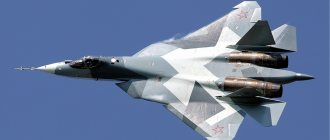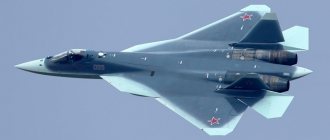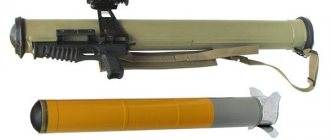The MiG-35 fighter is the latest multi-role fighter, the most advanced representative of the entire MiG aircraft family. MiG-35 aircraft belong to the 4++ generation, to the ideology of air fighters. Moreover, in terms of their combat qualities, they should prevail over fourth-generation fighters and serve to successfully confront fifth-generation fighters during air combat.
Mig-35 interceptors should become a solid alternative to fifth-generation aircraft, which are distinguished by their serious high cost. The Russian Air Force views the MiG-35 as a transitional link in generations. The newest interceptors, based on the airframe, are a logical continuation in the development of the unsurpassed MiG-29.
The delivery of fighter jets to the Russian Air Force began in 2014. The Russian Ministry of Defense has already formed several squadrons of interceptor fighters.
From the history of the creation of the MiG-35
Work on interceptors of the MiG-35 type began in the early 2000s. The first rollout of the aircraft was carried out only in January 2007. However, already in 2010 we were working with three prototypes that came into operation. These three samples took an active part in a wide variety of air shows, as well as in ongoing tests.
As previously mentioned, the MiG-35 was created on the basis of the MiG-29, as a result of which it was possible to establish production in the shortest possible time. They are extremely similar to their predecessors, but are “stuffed” with a completely new “filling”.
Mainly, this is the presence of:
- Lightweight airframe;
- The most modern avionics;
- Radar station with an active phased array antenna;
- The most promising types of weapons that had not previously been produced even in export versions;
- The most modern defense systems;
- Engines with increased resources.
The new aircraft model was distinguished by its excellent technical characteristics. The newest fighters were distinguished by their high speed, maneuverability, survivability, the most advanced weapons and other modern bells and whistles. But, what is most interesting, the cost of MiG-35 flight hours was almost two and a half times less than that of its predecessors, the MiG-29.
For example, even before 2006, the presented fighters were called MiG-29M/M2, and only later were they renamed MiG-35. Thus, during the MAKS-2005 air show, their prototype was demonstrated - a model of the MiG-29M OVT fighter. The establishment of industrial production of the MiG-35 was based on the groundwork obtained from the implementation of the MFI project, the leadership of which was entrusted to Vladimir Barkovsky, director of the engineering center of the Mikoyan Design Bureau.
The year 2007 was marked by the presentation of the MiG-35 to the Commander-in-Chief of the Russian Air Force, Vladimir Mikhailov, as well as to the Minister of Defense Sergei Ivanov. The negotiation process on the proposed provision of fighter jets had been going on since 2010, and only in 2014 there was a breakthrough, and things were destined to move forward. The fighters were included in the State Program for armament of the Russian Air Force until 2022.
Speech by the Deputy Prime Minister
Dmitry Olegovich Rogozin also spoke his weighty word about the MiG-35. Speaking immediately after the end of the multimedia presentation, he said the following: “I think that everyone present paid attention to the unique lines from which the appearance of the MiG-35 is woven. It was extremely important for us to develop this particular line of light fighters. They are traditionally characterized by lower cost in relation to competitors, and have huge export potential. At the same time, they are capable of solving any problems that arise on the battlefield. I think that the work to create such an aircraft has been successful.”
“You have seen the first - and very worthy - presentation of the revived experimental design bureau of Mikoyan and Gurevich. Today it is extremely important for us to stimulate competition among design and engineering work. I sincerely congratulate everyone who took part in this work. RSK "MiG" held the first presentation of the coming year in the combat aviation class. Ahead of us is the first flight of the MS-21 passenger airliner. And in the summer we will take off the light military transport aircraft Il-112V. Everything suggests that the potential of military aviation, the potential of design teams and production companies of the Russian Federation can be deployed to create high-quality, highly competitive aircraft. Russia is a great aviation power, and today we are dealing with serious confirmation of this fact. I invite all our friends, colleagues and partners in military-technical cooperation to familiarize themselves in detail with the MiG-35. Don’t waste your money, buy this plane!”
Then, in question-and-answer mode, Dmitry Olegovich added the following: “Traditionally, light fighters have a higher export potential because they are cheaper. We have always had a division - the MiGs were mainly light, and the Sukhoi fighters were heavier, with a larger combat load. It so happened that we had a big breakthrough in the production of multi-role fighters precisely developed by the Design Bureau named after. BY. Sukhoi. The Su-30MKI performed especially well. Such aircraft were and are being purchased in large quantities by India and entered service with Algeria and Malaysia. The Su-34 front-line bomber and the Su-35S multi-role fighter performed well during the Syrian operation. Next is the Advanced Aviation Complex of Frontline Aviation - PAKFA for short. All these aircraft are of the heavy class, but we still haven’t had anything new in the light class. Meanwhile, there was a big shortage on the market, a shortage of precisely this class of aircraft. And then the MiG-35 appeared. This is a breakthrough for our second design bureau! “I believe that with this aircraft we can pave the way for ourselves in the development of military-technical cooperation, since modern machines of this class are in demand on the global arms market.” Dmitry Olegovich said some of these words on the airfield after the completion of the demonstration flight of the MiG-35UB with tail number 712.
The aircraft was piloted by a crew consisting of: Mikhail Belyaev, head of the flight service, senior test pilot of RSK MiG and test pilot Stanislav Gorbunov. In the heat of events, we were able to hear only a short part of the communication between the pilots and the Deputy Prime Minister: “We are talking about the fact that this machine has a ship’s reserve, and then there is an increase in capabilities and modernization. In other words, the main ideology was a carrier-based aircraft, on the basis of which an airfield-based version is now being created,” said Mikhail Aleksandrovich.
Flight performance data of the MiG-35
The technical data of the MiG-35 differs:
- Crew of 1 or 2 pilots depending on the modifications of the MiG-35/MiG-35D;
- Length - 17.3 m;
- Height - 4.73 m;
- Wingspan 11.99 m;
- Wing area - 42 m²;
- Normal take-off weight - 17500 kg, empty - 11000 kg;
- Maximum take-off weight – 23500 kg;
- Two turbofan engines with OVT “RD-33MKV”;
- Maximum thrust - 2×5400 kgf;
- Maximum thrust during afterburner - 2×9000 kgf;
- Deflection angles of thrust vectors: ±8° in any direction, ±15° in vertical planes;
- Thrust vector deflection speed – 60 °/s;
- Engine weight – 1055 kg.
Modifications
Two modifications of the aircraft were produced:
- basic single-seat model Mig 35, created on the basis of the prototype with index 29;
- The MiG-35D is a two-seat version developed for deliveries to India, which has entered into a contract for the purchase of one hundred and twenty-six aircraft. This design could not win the tender.
With the exception of the specified feature in the number of crew members, there are no significant differences in the modifications.
MiG-35D
Flight TD MiG-35
The flight data of the MiG-35 differs:
- Maximum ground speed – 1400 km/h;
- Maximum speed at altitude – 2400 km/h;
- The practical range of a vehicle with an external fuel tank is 3000 km;
- Practical range without external fuel tank - 2000 km;
- Flight duration up to 2.2 hours;
- Practical ceiling – 17500 m;
- Thrust-to-weight ratio with maximum take-off weight – 0.77;
- Thrust-to-weight ratio with nominal take-off weight – 1.03;
- Wing load with maximum mass – 618 kg/m²;
- Wing load with a nominal take-off weight of 468 kg/m²;
- Maximum operational overload up to 9 g.
Armament of the MiG-35
The armament of the MiG-35 stands out:
- Built-in 30 mm GSh-30-1 cannon with a combat kit of up to 150 rounds;
- Hanging point: 10;
- Combat load – 6500 kg;
- R-73 short-range air-to-air guided missiles;
- Medium-range air-to-air guided missiles RVV-AE and R-27;
- Anti-ship missiles X-35 and X-31A;
- Kh-31P anti-radar missiles;
- Guided air-to-surface missiles: NAR, Kh-29, Kh-25;
- Air-to-air missiles Kh-29L, Kh-29T, Kh-25ML, RVV-AE, R-27;
- Adjustable and free-falling bombs, aircraft mines.
Structural features of the MiG-35 aircraft
They decided to increase the combat effectiveness of the aircraft by improving the avionics. It is precisely this equipment that distinguishes the MiG-35 from other fighters in the new unified family of MiG-29K/KUB and MiG-29M/M2: the share of avionics in fifth-generation devices and systems only increases from modification to modification.
In terms of its technological solutions, the MiG-35 fighter simply has no equal, at least in the European aircraft industry, because:
- The focus on the electronic component resulted from the excellent aerodynamic design of the MiG-29. Thus, during the design process of the MiG-35, there was a fifty percent increase in internal fuel reserves, as well as a two-fold increase in the combat load. For these reasons, the MiG-35's armament and range managed to increase to that of a heavy fighter;
- The maximum take-off weight was increased by a third, as a result of which it reached 23.5 tons. To maintain and improve flight performance, some improvements were made to the designs. For example, we increased the reliability of structures and improved the load-bearing qualities of the wings;
- The power plant has been updated. There was a replacement with RD-33MK engines, which have smokeless combustion chambers, increased thrust by 10%, longer service life and increased reliability. As an optional solution, they can install the modernized RD-33, which has an all-angle thrust vector deviation;
- The MiG-35 cockpit is equipped with the latest generation avionics, which is based on the principles of open architecture. It uses multiplex data buses with the MIL-STD-1553B standard. Thus, they ensured the multifunctional combat use of aircraft, and also simplified the integration of the latest types of weapons and equipment from domestic and foreign manufacturers, including outboard ones. To control weapons, we decided to use the principles of HOTAS. Three wide-format multifunctional eight-inch liquid crystal displays, as well as a wide-angle heading and glide path system, were installed in the cockpit information and control field;
- The basis for the MiG-35's weapons control was the use of: the latest radar stations with active phased antenna arrays "Zhuk-AE", OLS-K optical-location stations, as well as OLS-UEM optical-location stations, helmet-mounted target designation, indication and aiming systems NSCPI, which with their capabilities and characteristics correspond to the on-board system installed in fifth-generation aircraft. Optical-location stations with laser, television and infrared sighting devices are made using the latest space technologies that have not previously been used in aircraft construction. All this served to increase the survivability of aircraft and efficiency in combat use;
- We applied anti-corrosion technology to the main systems and airframes. This greatly facilitated the use of aircraft in tropical latitudes;
- Special technological and technical solutions have been developed for the MiG-35, ensuring complete autonomy when deployed. In particular, these could be on-board oxygen production stations.
Automation
To reduce the load on the pilot, the aircraft uses the SAU-451 automatic control system. In addition, equipment for limiting signals SOS-3M is being installed. The SUV-29 complex is responsible for targeting the target. It includes the RLPK-29 sighting system and the Ts100 BTsVM.
In general, modern aviation is focused specifically on shifting the responsibilities of pilots to complex computer systems as much as possible. This is understandable: the speeds of combat aircraft are such that a person’s reaction is simply not enough to adequately respond to a suddenly emerging threat.
The optical sighting system, represented by the OEPrNK-29 model, includes the OEPS-29 complex. Shchel-3UM has proven itself to be one of the best target indication systems in the world. CH-29 is responsible for navigation and route planning.
E502-20 “Turquoise” is used as equipment for command radio communications. The SPO-15LM “Beryoza” will inform the pilot in advance of approaching enemy radars. To prevent detection of the vehicle and impede the targeting of high-precision weapons, the Gardenia-1FU jamming equipment is used, as well as the PPI-26 equipment, which is responsible for the release of false targets.
Economic component and combat readiness of the MiG-35
The service life of the MiG-35 can be at least forty years. The aircraft's flight life can exceed six thousand hours. Aircraft have significantly increased the durability of engines and avionics. The aggregate number, which has limited resources, has been reduced by almost three and a half times compared to fighters of previous modifications.
This provides for an increase in the duration between maintenance services, optional overhauls, a reduction in their cost, as well as labor-intensive costs.
Distinctive characteristics
The machine is characterized by the following distinctive features:
- increased maneuverability, superior to analogues in terms of engine power with lower weight and better airframe characteristics;
- increased range of the combat radius, allowing you to achieve an advantage in access to remote objects;
- high combat survivability, significantly increasing the vehicle’s chances of success.
While superior to the prototype in equipment, the aircraft is not inferior to fifth-generation analogues in the most important indicators. Despite the external similarity with the prototype, the new fighter development is equipped with modern equipment.
Some features of the Mig-35 can be seen in the photo presented on the Internet, with a fairly high resolution of the image.
Export preponderance of Russian MiG-35s
Last year, S. Korotkov, General Designer and Vice President for Innovation of PJSC UAC, said that even then the latest design work was being carried out, which should have significantly surpassed existing analogues. He clarified that in the very near future the latest complexes will be demonstrated, including the MiG-35, which even then were extremely in demand in many countries around the world and had very great potential.
The radical improvement in the MiG-35's performance has served as a significant bargaining chip in the grueling battle for global markets that are increasingly focused on aircraft with low life cycle costs. Along with other factors, this bias is caused by a rather rapid increase in prices for aviation fuel.
Undoubtedly, the MiG-35 is the best solution for the Russian Air Force, as well as for the aviation of other countries, which have at their disposal a wide variety of early variations of the MiG-29. Based on some estimates by representatives of the Russian Air Force and foreign customers, the delivery of approximately 300–400 MiG-35 multirole fighters worth approximately twelve billion dollars is expected by 2022.











